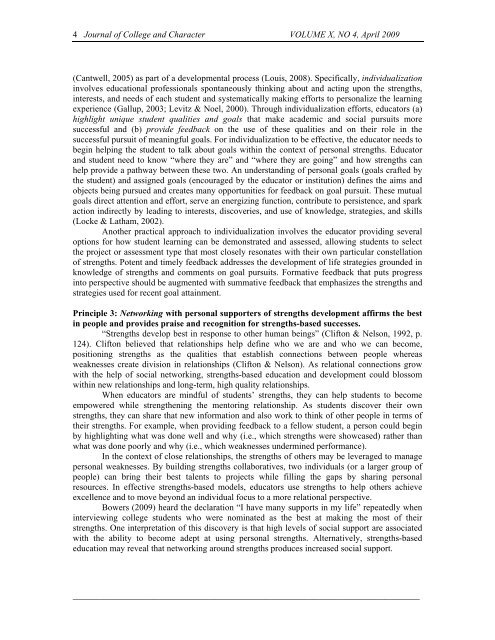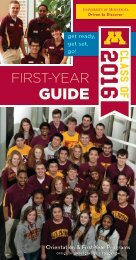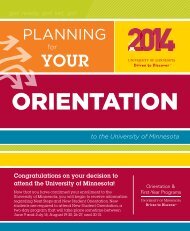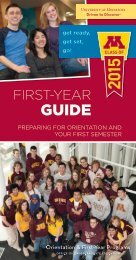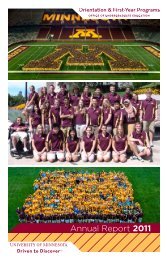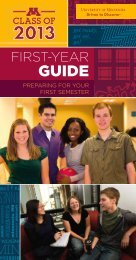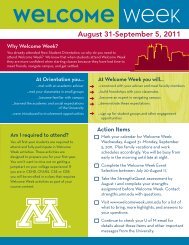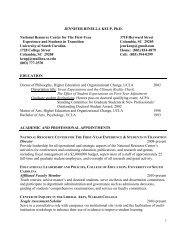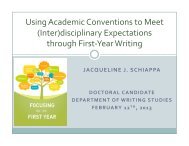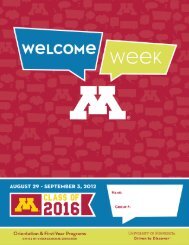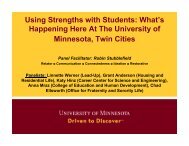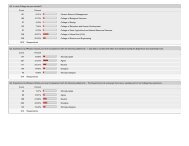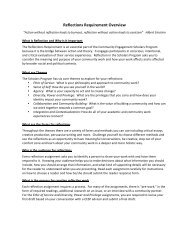The Principles of Strengths-Based Education - Orientation and First ...
The Principles of Strengths-Based Education - Orientation and First ...
The Principles of Strengths-Based Education - Orientation and First ...
You also want an ePaper? Increase the reach of your titles
YUMPU automatically turns print PDFs into web optimized ePapers that Google loves.
4 Journal <strong>of</strong> College <strong>and</strong> Character VOLUME X, NO 4, April 2009<br />
(Cantwell, 2005) as part <strong>of</strong> a developmental process (Louis, 2008). Specifically, individualization<br />
involves educational pr<strong>of</strong>essionals spontaneously thinking about <strong>and</strong> acting upon the strengths,<br />
interests, <strong>and</strong> needs <strong>of</strong> each student <strong>and</strong> systematically making efforts to personalize the learning<br />
experience (Gallup, 2003; Levitz & Noel, 2000). Through individualization efforts, educators (a)<br />
highlight unique student qualities <strong>and</strong> goals that make academic <strong>and</strong> social pursuits more<br />
successful <strong>and</strong> (b) provide feedback on the use <strong>of</strong> these qualities <strong>and</strong> on their role in the<br />
successful pursuit <strong>of</strong> meaningful goals. For individualization to be effective, the educator needs to<br />
begin helping the student to talk about goals within the context <strong>of</strong> personal strengths. Educator<br />
<strong>and</strong> student need to know “where they are” <strong>and</strong> “where they are going” <strong>and</strong> how strengths can<br />
help provide a pathway between these two. An underst<strong>and</strong>ing <strong>of</strong> personal goals (goals crafted by<br />
the student) <strong>and</strong> assigned goals (encouraged by the educator or institution) defines the aims <strong>and</strong><br />
objects being pursued <strong>and</strong> creates many opportunities for feedback on goal pursuit. <strong>The</strong>se mutual<br />
goals direct attention <strong>and</strong> effort, serve an energizing function, contribute to persistence, <strong>and</strong> spark<br />
action indirectly by leading to interests, discoveries, <strong>and</strong> use <strong>of</strong> knowledge, strategies, <strong>and</strong> skills<br />
(Locke & Latham, 2002).<br />
Another practical approach to individualization involves the educator providing several<br />
options for how student learning can be demonstrated <strong>and</strong> assessed, allowing students to select<br />
the project or assessment type that most closely resonates with their own particular constellation<br />
<strong>of</strong> strengths. Potent <strong>and</strong> timely feedback addresses the development <strong>of</strong> life strategies grounded in<br />
knowledge <strong>of</strong> strengths <strong>and</strong> comments on goal pursuits. Formative feedback that puts progress<br />
into perspective should be augmented with summative feedback that emphasizes the strengths <strong>and</strong><br />
strategies used for recent goal attainment.<br />
Principle 3: Networking with personal supporters <strong>of</strong> strengths development affirms the best<br />
in people <strong>and</strong> provides praise <strong>and</strong> recognition for strengths-based successes.<br />
“<strong>Strengths</strong> develop best in response to other human beings” (Clifton & Nelson, 1992, p.<br />
124). Clifton believed that relationships help define who we are <strong>and</strong> who we can become,<br />
positioning strengths as the qualities that establish connections between people whereas<br />
weaknesses create division in relationships (Clifton & Nelson). As relational connections grow<br />
with the help <strong>of</strong> social networking, strengths-based education <strong>and</strong> development could blossom<br />
within new relationships <strong>and</strong> long-term, high quality relationships.<br />
When educators are mindful <strong>of</strong> students’ strengths, they can help students to become<br />
empowered while strengthening the mentoring relationship. As students discover their own<br />
strengths, they can share that new information <strong>and</strong> also work to think <strong>of</strong> other people in terms <strong>of</strong><br />
their strengths. For example, when providing feedback to a fellow student, a person could begin<br />
by highlighting what was done well <strong>and</strong> why (i.e., which strengths were showcased) rather than<br />
what was done poorly <strong>and</strong> why (i.e., which weaknesses undermined performance).<br />
In the context <strong>of</strong> close relationships, the strengths <strong>of</strong> others may be leveraged to manage<br />
personal weaknesses. By building strengths collaboratives, two individuals (or a larger group <strong>of</strong><br />
people) can bring their best talents to projects while filling the gaps by sharing personal<br />
resources. In effective strengths-based models, educators use strengths to help others achieve<br />
excellence <strong>and</strong> to move beyond an individual focus to a more relational perspective.<br />
Bowers (2009) heard the declaration “I have many supports in my life” repeatedly when<br />
interviewing college students who were nominated as the best at making the most <strong>of</strong> their<br />
strengths. One interpretation <strong>of</strong> this discovery is that high levels <strong>of</strong> social support are associated<br />
with the ability to become adept at using personal strengths. Alternatively, strengths-based<br />
education may reveal that networking around strengths produces increased social support.<br />
______________________________________________________________________________


